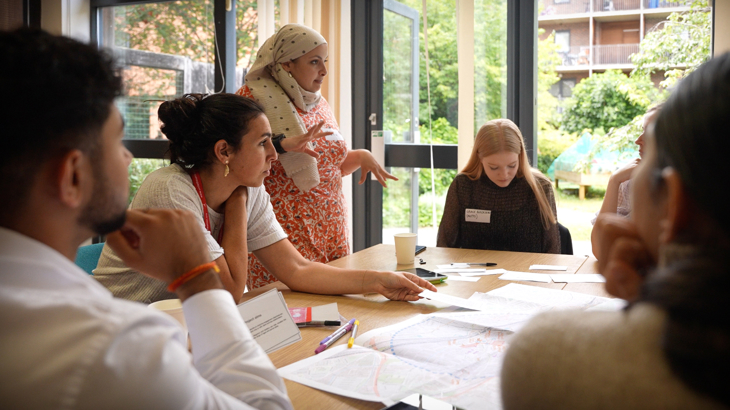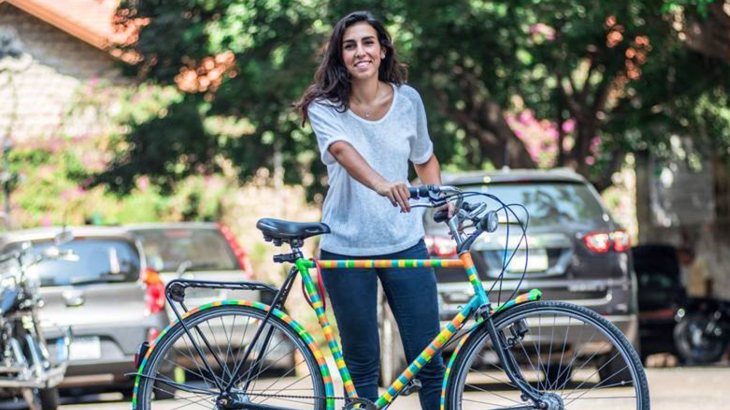We spoke to Zeina Hawa, Head of Design and Engineering at Sustrans in London, about the benefits and challenges of being a woman in engineering.

Zeina Hawa (second from left) in a meeting. Credit: Sustrans
What is your job?
Head of Design and Engineering - London
What inspired you to choose this job?
I moved into street design and engineering for active travel from my background in environmental engineering and urban and transport planning.
Growing up I was interested in environment and sustainability.
How people live in, move in, and shape their cities was such an interesting space to explore that.
I don’t think I realised that such a specific role existed, allowing me to combine urban design, engineering, transportation, cities, working with people and understanding human behaviour in one space.
What does a typical day in your job look like? What sort of projects are you likely to be working on?
Anything from giving Minecraft workshops to young people about street design outside schools, to painting shutters as part of a public space strategy, to designing cycle infrastructure, giving active travel design training to local authorities, specifying path buildups for new National Cycle Network paths, to being on site with contractors ensuring designs are built to spec.
Which aspects of the job do you love?
Engineering is a career that enables you to make a difference and contribute to the world in a tangible way.
I enjoy solving problems at higher level, and broadening the understanding of what engineering actually is, to more than just technical work, and highlighting the human and policy aspects of it.
I like working through the iterations and compromises.
Sometimes the best solutions are not the most technically sound ones.
Sometimes the simplest solutions can work best.
I love working with children and young people on street redesign that prioritises people over vehicles.
And highlighting spaces where engineering solutions are built into our day to day.
What are the challenges?
The high aversion to risk, and sometimes slow pace of change is one of the most challenging things for me in this field.
It’s great to see lots of local authorities being more ambitious in pushing forward impactful public realm and transport projects that improve the way people experience and move around cities.
However, there is also a reluctance to push forward some more impactful solutions.
It can be frustrating when public money is spent on diluted, incremental improvements, delivered over several years.
This is especially true after having worked on transformational schemes during the pandemic years.
We saw what governments and local authorities are capable of doing in short amounts of time if there was a will and political ambition behind it.
What is the gender balance like in engineering? How has that affected your work?
It’s pretty poor in the industry as a whole, but Sustrans is one of the few places where there is relatively good gender balance.
Highways engineering outside tends to be dominated by older male engineers, and there can sometimes be a sense of being taken less seriously as a younger female engineer.

Zeina Hawa. Credit: Zeina Hawa
Was there an occasion where your experience as a woman informed your design or engineering work?
Thinking about lighting and designing, and painting a huge mural with school children on a more secluded Sustrans path near Lower Sydenham station in London has probably been one of those experiences. The project also included opening up the path, to make it wider, more visible, smooth and accessible, as well as bringing in welcoming elements such as benches, and other light landscape features. The Sustrans team also worked with groups of volunteers to keep the space clean and cut back vegetation.
What is the one thing that you wish engineers/architects/city planners gave more consideration to when designing cities so that they are safer/more inclusive for women?
I think creating spaces and opportunities that cater mainly to women and children, and inviting these groups to use them would have a big impact. In parks, on streets, or through transport options that are more in line with how women tend to navigate cities.
Making spaces more inclusive by design is great.
But acknowledging that it is not enough on its own is important.
Socially, there is a lot of systemic exclusion, and oppression that has to be worked through to make streets truly inclusive.
I do think that programming and encouraging a wider variety of groups to use spaces, would also go a long way to help.
What would you say to young women considering about pursuing engineering as a career?
Absolutely do it! It’s empowering, interesting, and there is a huge need for more women in the industry
What advice do you wish you had been given when you were starting out?
To stick by the bolder ideas of street change I have.
And not let archaic views about how streets should function dilute ambitions for change.





